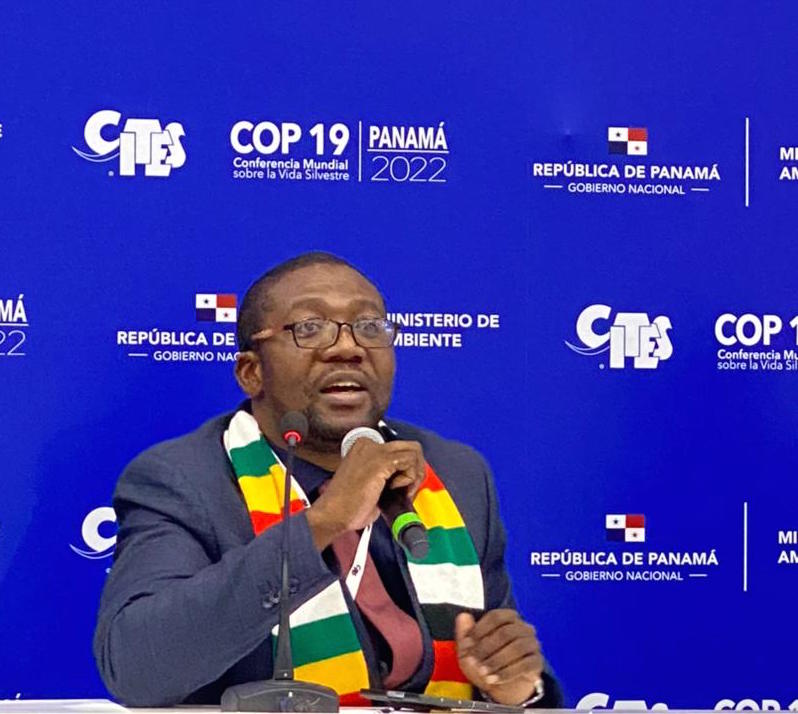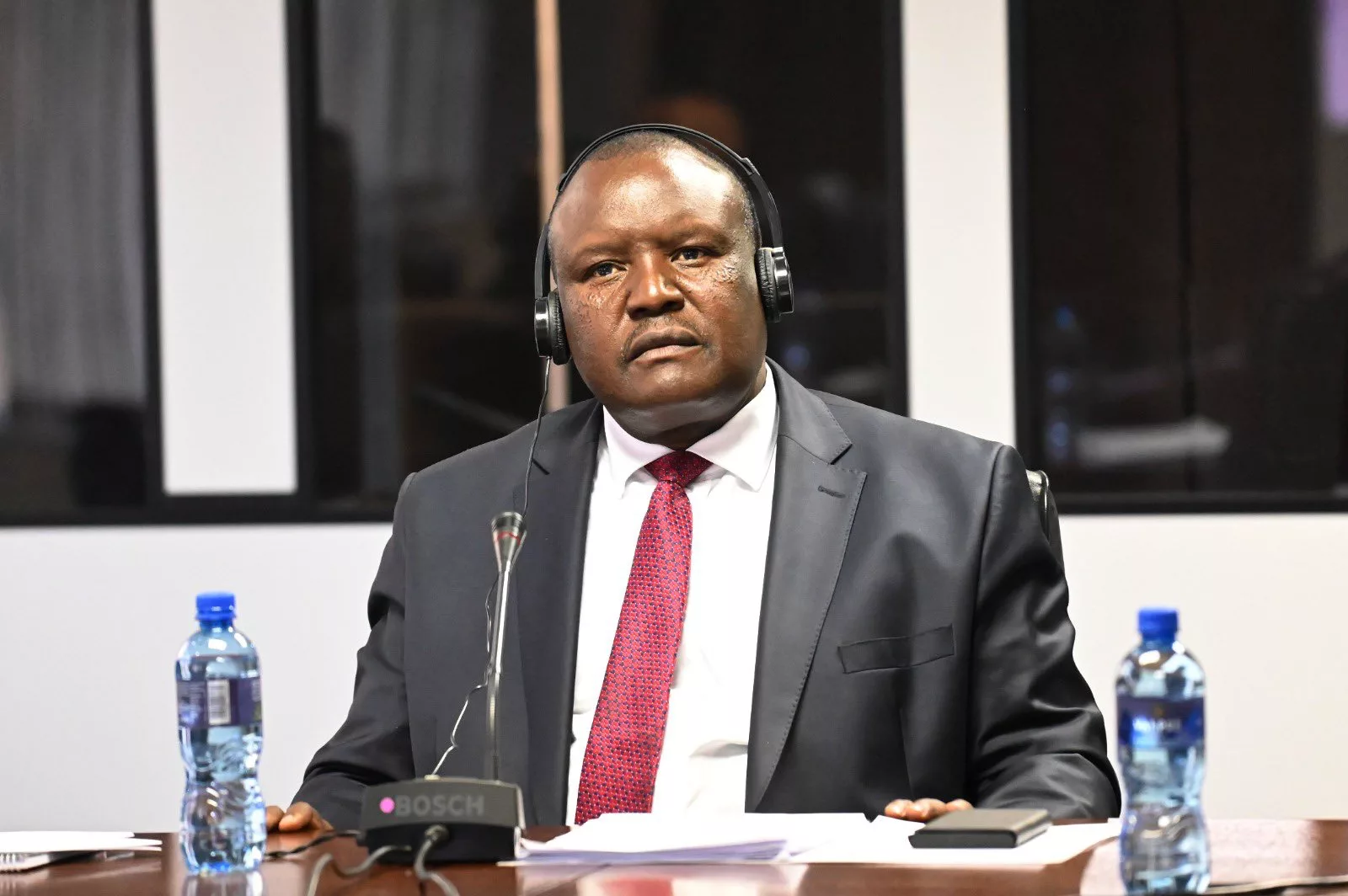|
Getting your Trinity Audio player ready...
|
The Minister of Environment Climate Tourism and Hospitality Industry Zimbabwe Hon Nqobizitha Mangaliso Ndhlovu is lobbying for the inclusion of local communities as an important part of the Convention on International Trade in Endangered Species of Wild Fauna and Flora (CITES) decision-making processes.
He revealed this at the 19th meeting of the Conference of the Parties (CoP19) to the Convention on International Trade in Endangered Species of Wild Fauna and Flora (CITES) currently underway in Panama City in Panama from 14-25 November 2022.
“Ladies and gentlemen, it is now widely recognized that Community-based natural resource management promotes sustainable use of wildlife and reduces illegal use and trade in wildlife. It fosters the support of local people for conservation, by generating income and stimulating local economies. The Preamble of the CITES Convention recognises that “peoples and States are and should be the best protectors of their own wild fauna and flora”,” Hon Ndhlovu said.
The meeting convenes at a time when the health of the planet is under threat. Biodiversity is one of the main indicators of the planet’s health and the fact that so many species are thought to be at increased risk is a worrying trend.
The Minister noted that CITES is turning 50 and yet it does not have a mechanism that effectively addresses the social consequences of trade and listings. He said the strictly biological focus on the sustainability of wildlife harvesting and trade is never going to lead to holistically effective responses because sustainability in the use of any species is usually embedded in sustainability considerations at the scale of the whole ecosystem, and this, in turn, is embedded in larger social systems with cultural, economic and political dimensions.
Hon Ndhlovu acknowledges that the CITES Resolution Conf. 8.3 (Rev CoP13) recognizes that implementation of CITES-listing decisions should consider potential impacts on the livelihoods of the poor.
“But then the key question becomes the ‘How’. There is nothing for communities without the communities living with endangered species in trade. We also know Articles 18 and 41 of the UN Declaration on the Rights of Indigenous Peoples respectively affirms that Indigenous people “have the right to participate in decision making in matters which would affect their rights” and that “ways and means of ensuring participation of indigenous peoples on issues affecting them shall be established”. What have we done about this under the CITES framework? The CITES Secretary-General talked about the need to reflect and indeed we need to reflect on how we have fared.
“One of the challenges facing endangered species is transnational organised crime and to address the matter, the United Nations General Assembly, on 30 July 2015 adopted Resolution A/RES/69/314 on “Tackling illicit trafficking in wildlife”, which strongly encourages the full engagement of the communities in and adjacent to wildlife habitats as active partners in conservation and sustainable use, enhancing the rights and capacity of the members of such communities to manage and benefit from wildlife and habitat,” he said.
Moreso, the United Nations General Assembly on 25 September 2015, adopted Resolution A/RES/70/1 on “Transforming our world: the 2030 Agenda for Sustainable Development”, which includes a set of 17 goals and 169 associated targets and in particular target 15.c that requests UN Member States to enhance global support for efforts to combat poaching and trafficking of protected species, including by increasing the capacity of local communities to pursue sustainable livelihood opportunities.
Considering these efforts under the UN banner, Hon Ndhlovu said CITES cannot continue to lag behind on community engagement in its decision-making processes.
“We need to respect, preserve, and maintain knowledge, innovations, and practices of indigenous peoples and rural communities embodying traditional lifestyles relevant to the conservation and sustainable use of CITES-listed species. When decision-making mechanisms at the CITES level consider the needs of people sharing the land and obtaining their livelihoods from wildlife and acknowledging that rural communities are best placed to advocate their needs; then CITES become a progressive treaty.
“In the absence of full and meaningful involvement of Indigenous peoples and local communities, CITES is less effective, if not counter-productive. Local communities determine how local action is pivotal in promoting sustainable development and addressing our planetary crises. The agenda of protecting individual species and reviving ecosystems must go hand-in-glove with the inclusion of local communities.”
A global population of 7.8 billion people is demanding innovative conservation strategies — strategies that reflect ecological and political realities and community involvement in CITES decision-making is a real game-changer.
The recent IPBES Sustainable Use Assessment (IPBES 2022) reaffirms that “the long history of sustainable uses of wild species in these areas has played a role in maintaining and increasing local levels of biodiversity while supporting indigenous peoples’ well-being and livelihoods” and that “loss of opportunity to engage in sustainable use of wild species represents an existential threat to indigenous peoples and local communities.”
History chronicles the plight of local communities as the conservation paradigms unfolded and they cannot continue to be disenfranchised in decision making affecting their livelihoods. Therefore to promote reconciliation and redress for past injustices, firmly placing local communities on the conservation agenda across all levels — from international, regional, and local. In other words, recognition of local and Indigenous land and resource rights must be prioritized. Social justice is crucial to the success of conservation efforts in the post-2020 global biodiversity framework currently being negotiated. This matter must get the attention it deserves under CITES.
Various international human rights agreements protect equity and promote equality for different groups, including vulnerable communities, in terms of access to and sustainable use of natural resources. However, structural barriers, including a lack of access to information or stigma remain in place and undermine the efforts of communities to protect the biodiversity they depend upon.
While other Environmental agreements such as the Convention on Biological Diversity (CBD), the United Nations Convention to Combat Desertification (UNCCD), and the United Nations Framework Convention on Climate Change (UNFCCC) have established proper Platforms, Forum of Caucuses to allow IPLCs to participate and contribute to their decision making, CITES is still far from forming a meaningful system to allow proper participation of IPLC apart from their possible participation in Countries delegations or as Observers.
The Minister said more participation by local communities and their representation in CITES decision processes will result in greater compliance and strong local leadership which is all linked to better ecological and biodiversity outcomes. Local communities are at the heart of global efforts to sustain a healthy world where nature and human well-being are linked. In the era of climate change and the opportunity to reimagine the global economic model, a renewed focus on the community may be what is really needed.
The participation of indigenous peoples and rural communities in the CITES decision-making mechanisms has been almost completely neglected and the power is in our hands to change the narrative. This is very important because the lack of community engagement is one of the main causes of increased illegal trade in wildlife and this neglect has far-reaching ramifications. CITES has not established any mechanism to assess the social consequences of listing species in the Appendices, and when CITES makes decisions that restrict trade, without consultation with the people that share their land and livelihoods with wildlife, unintended consequences, such as increased poaching, are to be expected.
In participating at the CITES 19th COP, the minister believes it is in the best interest of CITES to establish a cross-cutting Rural Communities Advisory sub-Committee (which advises both the Plants and Animals Committee) composed of Parties, Rural Communities Organizations or IPLCs Organisations in accordance with specific criteria and with the task to operationalize principles embodied in the Preamble to the Convention as well as Resolution Conf. 8.3 (Rev. CoP13) on recognition of the benefits of trade in wildlife, and Resolution Conf. 16.6 (Rev.CoP17) on CITES and livelihoods in full participation in the ongoing processes aimed to achieve the Sustainable Development Goals of the UN 2030 Agenda for Sustainable Development.






